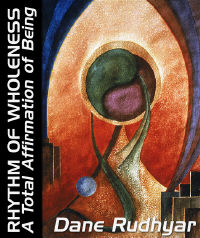 |
| Home | Bio | Art | Music | Literature | Civilization & Culture | Philosophy of Wholeness | Theosophy & Spirituality | Astrology |

RHYTHM OF WHOLENESS A Total Affirmation of Being by Dane Rudhyar, 1983 CONTENTS PROLOGUE PART ONE The Philosophy of Operative Wholeness 1. Prelude to a New Interpretation of Reality 2. The Search for Spiritual Security: The One, the Whole, and Wholeness 3. The Movement of Wholeness PART TWO The Cycle of Being 4. The Structure of the Cycle of Being 5. The Four Crucial Phases of the Cycle of Being 6. The Inevitability of Success and Failure 7. Spirit and Mind PART THREE The Cycle of Man 8. Constitution of Man - The Physical and Psychic Bodies 9. Constitution of Man - The Spiritual Entity and the Higher Mind 10. The Structure and Transformation of the Total Person 11. The Cyclic Process of Spiritual Embodiment PART FOUR In The Spirit of Wholeness 12. The Principle of Holarchy and the Interplay of Horizontal and Vertical Relationships Page 1 Page 2 Page 3 Page 4 Page 5 13. Transpersonal Activity versus Mediumship 14. Rites of Passage EPILOGUE |

CHAPTER TWELVE
The Principle of Holarchy and the Interplay of Horizontal and Vertical Relationships - 2 Holism and a hierarchy of levels The official trend in modern science is still mainly atomistic and focuses considerable attention on horizontal relationships — a focusing which is even more dominant in sociology, politics, and popular psychology. The new trend toward the holistic approach offers a logical basis on which a more inclusive concept of vertical relationships can develop. A passage from the book Accent on Form by L. L. Whyte, a British philosopher of science, may be worth quoting here, because it provides apt characterizations of these two approaches. According to Whyte, the "Atomistic School" of knowledge has been represented in the European past by "Leucippus, Democritus, Gassendi, Newton, Boyle, Dalton and contemporary atomic physicists" (his book was written in 1953); among the leaders of the "Holistic School" he lists "Goethe, Bergson, the Gestalt psychiatrists, Whitehead, and Jan Smuts."(1) The classical atomistic doctrine asserts that the universe is made up of ultimate particles, each of which is simple, indivisible, and permanent. All observable changes are due to the reversible spatial rearrangements of these particles resulting from their motions and mutual influences. The particles although small must be of a finite size or effectively occupy a definite volume of space, since a finite number of them make up ordinary objects. Moreover if atomism is to work there must be very few different kinds of ultimate particles, for the aim is to simplify our view of nature. The complexity of observed phenomena is to be accounted for as the result of the motion of units which are each simple and permanent. This program had the great advantage that it gave physical measurement and mathematic reasoning something to grip. . .These two schools of thought are not mutually exclusive; Whyte foresaw their harmonization in a "School of Elegant Structure combining an intuition of the whole with the analytical recognition of detail." Since the late 1960s, an important group of philosophers of science, including Ludwig von Bertalanffy and Erwin Laszlo, has indeed been developing a "general system theory" and a "systems philosophy" in which what I call a "whole of being" is more generally and abstractly referred to as a "system." The two aspects of the principle of relatedness — vertical and horizontal — have been mentioned and their implications studied both by "esoteric" groups (for example, the Arcane School founded by Alice Bailey) and philosophers of science, especially Arthur Koestler in his books The Ghost in the Machine and Janus: A Summing Up.(3) Koestler spoke of the universe as the "holarchy," using a new word which I also had coined, entirely unaware that he already had done so. But he uses the word in a somewhat different sense from my own use, he speaks of "the" holarchy as if it were an entity, while I consider holarchy as a principle of organization. Several basic questions pertaining to relationships (especially vertical ones) are: How fundamentally different are the activities and the characters of entities operating at the different levels? What are these levels? How few or numerous are they? One can have in mind a few distinct realms (cosmic and planetary, spiritual and material) or one can refer only to levels of organization, authority, or power in the sphere of politics, religion, and culture. When intensely democratic or "new age" enthusiasts proclaim the basic value of horizontal relationships and denounce all vertical relationships — even in the family — as obsolete and destructive of the supreme rights of each individual to meet all other persons as equals, the words vertical and horizontal refer only to the level of culture and personhood. Such persons dream of a society entirely controlled by egalitarian principles; a society in which all persons operate at the same level as theoretically self-conscious and responsible sociopolitical atoms. In such a sociopolitical cultural system a person is a characterless unit, an abstract number in vote tabulations and popular polls and in proliferating statistical researches undertaken by commercial or other special interests. Total egalitarianism and absolute individualism are analogous in social terms to what the end of the process of entropy is thought to be in physics. In actual fact, there always are among equals — some who are "more equal."(4) Any perspicacious advocate of horizontal equality should rightfully challenge and transform any system of social or political organization in which hierarchical structures are rigidly set — and especially in which power, wealth, or educational privileges are inherited. In such organizations hierarchical structures constitute a hierarchy of command, not of containment. At one time a feudal lord was believed to own all the land and people living around his large, fortified castle; but his subjects found refuge within the castle's walls when the land was attacked. In that sense at least, the lord "contained" his subjects; they existed within his sphere of containment, the realm where his power was effective. This realm was like a mandala whose center was the castle and its chapel. At least in principle, the lord acted "in the name of" the realm and all it contained. He provided security to those he ruled. The relationship was indeed vertical but theoretically impersonal; it was given a vital, ritualized character. Being vital it also was sacred, because at that time religion was still fundamentally vitalistic, in spite of its transcendent beliefs. Vertical relationship is implied whenever one can truly speak of ritual. A vertical relationship links at least two or in most cases three basically different levels of being. The cultural level at which the ritualized and sacred act is performed is not only rooted in biological values; the rite also reflects a transcendent spiritual reality the scope of which is all-human and planetary. Any truly powerful and inherently transformative symbols, myths, or rites should be considered instrumentalities consciously or unconsciously intended to serve as channels of communication (or links) between the level of spiritual process (archetypes) and that of living organisms (the biosphere). 1. Jan Smuts, the South African philosopher-statesman prominent during the formulation of the League of Nations at the end of World War I, wrote in 1926 a seminal book, Holism and Evolution, which provides a new interpretation of evolution in the broadest sense of the term. It was Smuts who coined the words holism and holistic; the popular use of the latter may or may not always be justified. Return 2. Accent on Form by L. L. Whyte (New York, 1954) pp. 53f. Return 3. Arthur Koestler, The Ghost in the Machine (New York: Macmillan, 1968); Janus: A Summing Up (Vintage Books, New York, 1978). Return 4. For a discussion of the concept of equality, see my books We Can Begin Again — Together, pp. 46-51 and Culture, Crisis and Creativity, pp. 161-65. Return By permission of Leyla Rudhyar Hill Copyright © 1983 by Dane Rudhyar All Rights Reserved.  Web design and all data, text and graphics appearing on this site are protected by US and International Copyright and are not to be reproduced, distributed, circulated, offered for sale, or given away, in any form, by any means, electronic or conventional. See Notices for full copyright statement and conditions of use. Web design copyright © 2000-2004 by Michael R. Meyer. All Rights Reserved. |
 |